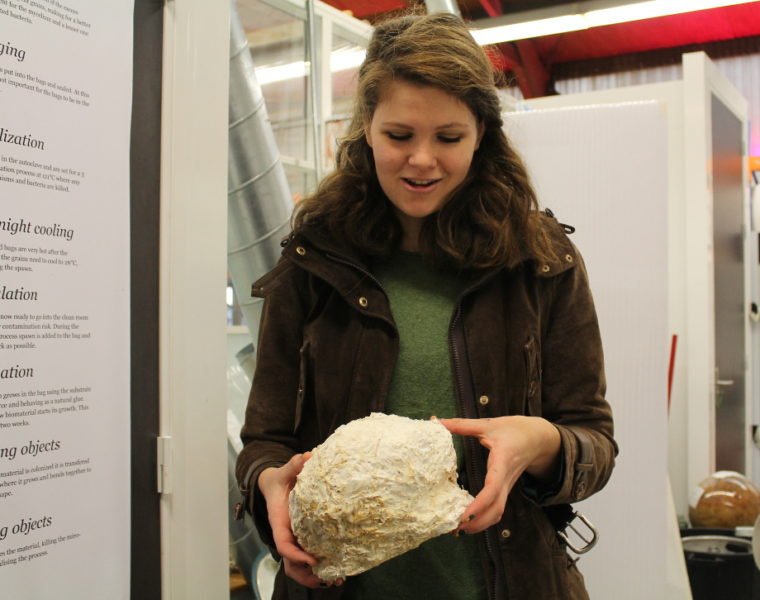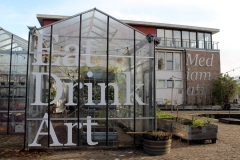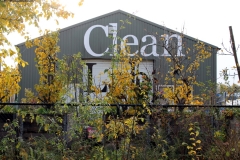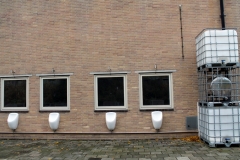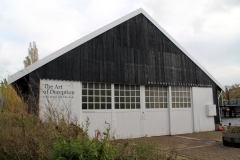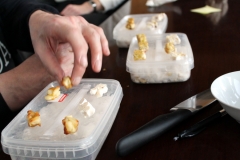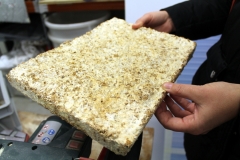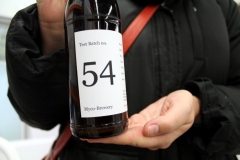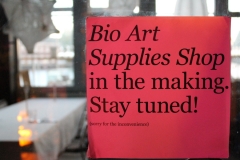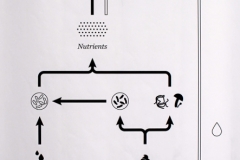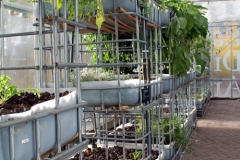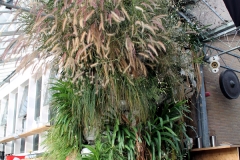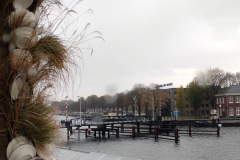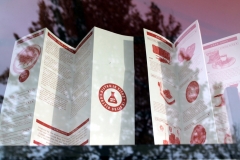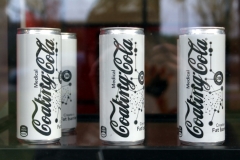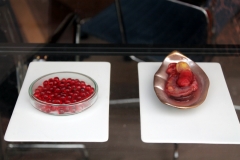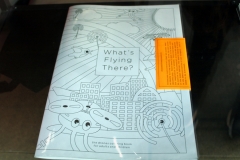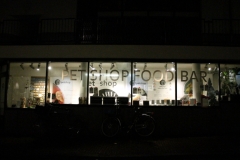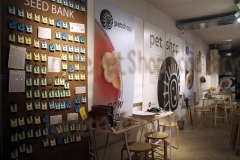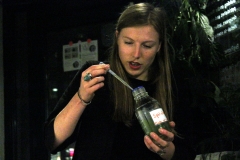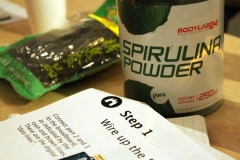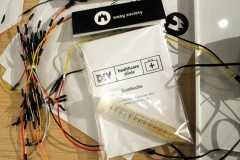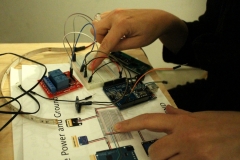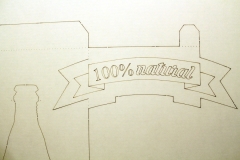Superfood, Aquaponics & Nano Wine … A research trip to Amsterdam
17 -19 November 2016
Joined by fellow artist and current collaborator Alexia Mellor, we embarked on a research trip focussing on two organisations in the Dutch capital Amsterdam- ‘Mediamatic’ and ‘WAAG Society’ working at the intersection of art, science, food and technology. Our focus was to plug into conversations, network and engage in the current dialogue in the new language of an old media- ‘bio-art’. Specifically our research in Amsterdam centered on the unseen yet prolific and consistent transformers in our food system- micro-organisms (bacteria, yeasts, fungi & algae). Not only are they the new stars in the culture industry they are also at the forefront of a massive change within the techno-scientific realm of synthetic biology. The imaginary future is nearly here- new forms of energy, fuels, food, cosmetics and experiences are under development in the laboratories of small ‘start-ups’ and global corporations, all pledging a ‘clean and ‘green’ future.
How are artists, designers and cultural organisations critically and conceptually engaging with this new area of ‘bio-hacking’. Why is the Netherlands at the forefront in the engagement of this new area ?
We talked to artists, designers, foodies, hackers, fermenters, brewers and cultural developers on our destination list- Mediamatic and WAAG Society in Amsterdam to find out what they have been up to with these invisible yet prominent organisms … and what a diverse range of micro-organisms we encountered.
We hacked the superfood and cyanobacterium algae ‘spirilina’ at the WAAG ‘Petshop Food Bar’, tasted the ‘rhizopus oligosporus oryzae’ fungus at a impromptu tempeh tasting, came home with a saccharomyces and gluconacetobacter xylinus kombucha scoby, spoke to the in-house brewer about his ‘saccharomyces cerevisiae’ yeasty beer editions and the to an expert about the role played by the ‘nitrospira’ and ‘nitrosomanas ‘species of bacteria in aquaponics cycle.
Our first stop was ‘Mediamatic’ to meet artist and Mediamatic fellow Zeger Reyers. Zeger is an artist ‘fascinated by biological processes like eating and growing, budding, blossoming and dying’. Whilst ingesting a delicious soup made primarily from the fungus ‘Pleurotus ostreatus’ (oyster mushroom) cultivated in-house we chatted to Zeger regarding the ethics of working with ‘live’ materials, transparency and the notion of ‘micro’ and ‘macro’ scale within our collaboration of enclosed systems. Zegers pointed to his latest installation– ‘Hard Water’, an installation of 1000 stacked dish-plates growing wild grasses within the internal and external structure of the Mediamatic restaurant / café to exemplify the relationship between systems.
Mediamatic is a cultural venue which likes ‘explore the possibilities and challenges that new technology offers art, design and society’. It has been on my radar from sometime as I have been fascinated by its’ diversely engaged works, event and projects, in particular its’ ‘Myco’ research, ‘Bio Clean Lab’ and ‘Bio Art Supplies Shop’. Others however equally drew my attention including their ‘aquaponics garden/park’ and the ‘Pis’ Project’. You may have guessed what this is about, yes urine. The exterior installation ‘Pure gold’ at Mediamatic, is currently collecting urine to be utilised as a fertiliser.
Mediamatic is a rare cultural organisation. Director Jans Possel personally showed us around the Mediamatic complex, known as the ‘biotoop’ (habitat) – which consists of a series of external and internal spaces for exhibitions, installations, growing, cultivating, working and of course, eating.
We were introduced to the ‘Bio Clean lab’ by Jans which hosts the Mediamatic in-house ‘myco brewery’, a mycelium & mushroom cultivation lab led by Linde van Beers (whom incidentally also nurtures silkworms for costumized fabrics), a tempeh inoculation space and an area for artists use. The ‘myco-brewery’ is also an intelligent and innovative use of materials, combining the brewing process with the production of ‘smart’ materials. The spent grains from brewing are utilised as a substrate for growing mycelium spores (the root type threads of fungus/mushroom which grow underground of the fruit) for ‘myco panels‘. The current and expanding applications of the ‘myco panels’ include insulation panels/bricks and food packaging.
Finally we got to see what was in the large and abundant greenhouse- it was an ‘aquaponics’ system, a closed loop or ‘micro’ & ‘macro’ organisms of bacteria, plants, catfish & nutrients- for serving in Mediamatics café / restaurant . Concerned with the heavy and micro pollutants of our land, air, sea and rivers Saro Van Cleynenbreugel, the resident expert in ‘aquaponics’ talked us through the entire system as part of a day-long workshop, finally constructing a viable system which could produce plants from fish waste as nutrients, and ‘home’ nurtured fish to eat.
The other main impetus to visit Mediamatic was for its ‘Bio Art Supplies Shop’. This however we were disappointed to find that it was currently under-development. Still, it’s a great idea- instead of paints, canvas and paper for artists we will have bio-materials, tools and guides. I will keep my eyes peeled for this for sure.
The other organisation we targeted in our research trip was the WAAG Society. I have a vague memory of WAAG Society from another time. Pre-ADSL I had worked on a live networked collaborative between London and Amsterdam. It still seems to be at the forefront of numerous collaborative and networked projects. We met up with Iris de Vries at the ‘Pet Shop Food bar’ (a conceptual ‘shop’ which is full of microbial ‘pets’ to take away, culture and nourish) and joined her small workshop on how to ‘Hack Your Superfood- Spirilina’. We talked about tools, techniques and how the of once marginal organisms like spirilina are propelled into the forefront of the synthetic biology revolution.
The Pet shop is an interesting project bringing the far too often invisible organisms in our food chain to the front with hands-on engagement. As we were leaving Iris gave us a parting gift from the Pet Shop, some kombucha for us to nurture and ingest.
Whilst in town we also thought that we would swing by the ‘Next Nature Network’s‘ offices. “The Next Nature Network is a 21st century nature organization that wants to go forward – not back – to nature”.
I have been trying to acquire a bottle of Next Nature’s ‘Nano Wine‘ for some time now. Usually out of stock on-line, I tried my luck to see if we could pick one up and see if anyone would be around to speak to Alexia and myself briefly about Next Nature and some of their other projects tackling, food, technology and climate change, particularly the ‘ECO Coin’.
Unfortunately we weren’t able to go forward to the next nature as the offices were closed to the public. Instead we peered into the next nature window display of convincingly real speculative products of a ‘post-nature’ scenario from the ‘Nano Supermarket’; ‘in-vitro meat’ dishes, ‘Bistro in-vitro’ menu (for which I have a booking for in 2028), Rayfish footwear and ‘Coating Cola’. I will endeavour however to keep myself informed in Next Natures activities whilst sipping a glass of Nano Wine.
This was a packed, immersive and thought-provoking visit. During our limited time in Amsterdam we were able to discuss notions of post, new, and next nature contextually, whilst examining materiality of bio-led art & design openly with peers and through pragmatic activities. We certainly hope to remain in contact with the organisations and individuals we encountered in Amsterdam not only to expand our professional support network but also as a way to share concepts and pragmatic activities…. in the meantime though we have our kombucha scoby.
• Zeger Reyers
• Pet Shop Food Bar– workshop: hack your superfood
• Jans Possel. Mediamatic Biotoop
• The Art of Deception. Designer Isaac Monté and evolutionary biologist Toby Kiers
• Stofpluizen, Pavèl van Houten.
• Pure Gold
• Pis’ project
• Learn to build Aquaponics- Workshop
• Next Nature Network
